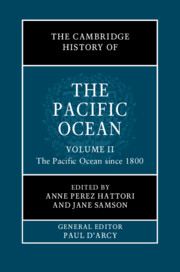Book contents
- The Cambridge History of the Pacific Ocean
- The Cambridge History of the Pacific Ocean
- The Cambridge History of the Pacific Ocean
- Copyright page
- Contents
- Figures
- Tables
- Contributors to Volume II
- Frontispiece
- General Editor’s Introduction
- Preface to Volume II
- Part VII Rethinking the Pacific
- Part VIII Approaches, Sources, and Subaltern Histories of the Modern Pacific
- Part IX Culture Contact and the Impact of Pre-colonial European Influences
- Part X The Colonial Era in the Pacific
- Part XI The Pacific Century?
- 54 The USA and the Pacific since 1800
- 55 World War II and the Pacific
- 56 The Nuclear Pacific
- 57 Shrinking the Pacific since 1945
- 58 China and the Pacific since 1949
- 59 Pacific Island Nations since Independence
- Part XII Pacific Futures
- References to Volume II
- Index
58 - China and the Pacific since 1949
from Part XI - The Pacific Century?
Published online by Cambridge University Press: 11 November 2022
- The Cambridge History of the Pacific Ocean
- The Cambridge History of the Pacific Ocean
- The Cambridge History of the Pacific Ocean
- Copyright page
- Contents
- Figures
- Tables
- Contributors to Volume II
- Frontispiece
- General Editor’s Introduction
- Preface to Volume II
- Part VII Rethinking the Pacific
- Part VIII Approaches, Sources, and Subaltern Histories of the Modern Pacific
- Part IX Culture Contact and the Impact of Pre-colonial European Influences
- Part X The Colonial Era in the Pacific
- Part XI The Pacific Century?
- 54 The USA and the Pacific since 1800
- 55 World War II and the Pacific
- 56 The Nuclear Pacific
- 57 Shrinking the Pacific since 1945
- 58 China and the Pacific since 1949
- 59 Pacific Island Nations since Independence
- Part XII Pacific Futures
- References to Volume II
- Index
Summary
This chapter outlines the evolution of the People’s Republic of China’s (China) interactions with the Pacific Ocean since its formation in 1949. China inherited a long history of engagement with Pacific oceanic environments and other nations that inhabit its shores. After briefly outlining the post-war legacy of these interactions through maritime trade, fishing, diplomacy, and migration, the chapter details the history of China in the Pacific since 1949. It is a story of two distinct eras. Until 1978, China focused inwards to repair and restructure a nation torn apart by war, disunity, and neglect of the majority of the population. Its Pacific interactions focused largely on defending its sovereign waters and harvesting its coastal fishery, while its diplomatic stance further afield espoused solidarity for the decolonization and sovereignty of fellow developing nations. From 1978, China increasingly focused on economic reform, involving greater engagement with the overseas economy as it rapidly rose to become a global powerhouse of manufacturing. Two engagements with the Pacific are explored for this period. The first is China’s engagement with the Pacific Ocean as an environmental space, and especially a fishery and sea lane resource. The second is the expansion of China’s diplomatic and strategic engagement with the wider Pacific community from the 1970s. The final section looks at present and future engagements with Pacific Island nations in particular, as the nations that are under the most immediate threat of climate change damage. China has competitive advantages in skills and technologies vital to its Pacific allies and a long history of productive partnerships with them.
- Type
- Chapter
- Information
- The Cambridge History of the Pacific Ocean , pp. 664 - 682Publisher: Cambridge University PressPrint publication year: 2023



